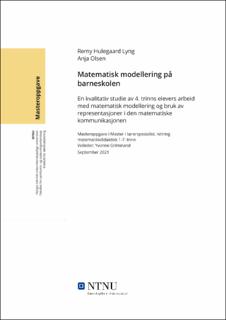| dc.contributor.advisor | Grimeland, Yvonne | |
| dc.contributor.author | Lyng, Remy Hulegaard | |
| dc.contributor.author | Olsen, Anja | |
| dc.date.accessioned | 2023-04-18T17:19:36Z | |
| dc.date.available | 2023-04-18T17:19:36Z | |
| dc.date.issued | 2021 | |
| dc.identifier | no.ntnu:inspera:90243908:34083569 | |
| dc.identifier.uri | https://hdl.handle.net/11250/3063659 | |
| dc.description.abstract | Denne studien har undersøkt hvordan et utvalg elever på 4. trinn løste en modelleringsoppgave ut fra et presentert problem fra virkeligheten. Vi har sett på hvordan elever i en modelleringssyklus bruker representasjoner da de kommuniserte med og om matematikk, i delprosessene matematisering og matematisk arbeid. Studien har undersøkt følgende forskningsspørsmål:
Hvordan utvikler et utvalg 4. trinns elever matematiske modeller i delprosessene matematisering og matematisk arbeid, og hvordan bruker elevene representasjoner i kommunikasjonen med og om matematikk?
Hensikten med studien har vært å få innsikt i hvordan noen elever utvikler og arbeider med matematiske delprosesser og se hvordan de bruker representasjoner i de ulike prosessene.
Studien har brukt kvalitative metoder med observasjoner, elevarbeid og gruppeintervju. Datamaterialet har blitt analysert ved hjelp av induktive og deduktive analyser. Studien viser hvordan elever kan arbeide med matematisk modellering i barneskolen, noe som kan danne grunnlag for refleksjon om undervisningspraksis innen matematisk modellering. Resultater fra studien har vist at noen elever på 4. trinn har delkompetanse til å utvikle matematiske modeller i delprosessene matematisering og matematisk arbeid. Elevene utviklet modeller basert på egne målinger og brukte mønstre som tok utgangpunkt i differanser. Da elevene selv måtte identifisere et mønster og ta et valg om hva de skulle ta hensyn til i modellen, utviklet de forskjellige matematiske modeller basert på mønstret fra hele tabellen eller forrige strikklengde. Etter hvert som kompleksiteten i oppgaven økte, ble forskjellene mellom strategiene og modellene større og større. Da elevene kommuniserte om og med matematikk viste funnene at elevene i hovedsak brukte naturlig språk i skriftlig kommunikasjon med og om matematikk. I den muntlige kommunikasjon brukte elevene naturlig språk da de kommuniserte fremgangsmåte og resultat. I beregning av strikker for det store hoppet brukte noen grupper symbolspråk for å beregne antall strikker. Selv om matematisk modellering er en kompleks prosess, indikerer funnene i denne studien at det er mulig å gjennomføre en eller flere deler av en modelleringssyklus i barneskolen.
Nøkkelord: Matematisk modellering, modelleringskompetanse, representasjoner | |
| dc.description.abstract | This study has examined how a sample of students in the 4th grade solved a modeling task based on a presented complex real-world problem. We have looked at how students, in a modeling cycle, use representations to communicate mathematically, in the subprocesses mathematising and working mathematical. The study has examined the following research questions:
How do a selection of 4th grade students develop mathematical models in the subprocesses mathematising and working mathematical, and how do students use representations in communication with and about mathematics?
The purpose of the study has been to gain insight into how some students develop and work with mathematical subprocesses and see how they use representations in the different processes.
The study has used qualitative methods with observations, student work and group interviews. The data was analyzed using inductive and deductive analysis. The study shows how students may work with mathematical modelling in the primary school, which may support the basis of reflection in mathematical modelling education. Results from the study has shown that some students in the 4th grade have sub competencies to develop mathematical models in the subprocesses mathematizing and working mathematical. The students developed models based on their own measurements and used patterns which used difference. When the students had to identify a pattern and elicit their own mathematics as they had to decide what to take into account in their model. The students developed different mathematical models based on the pattern from the entire table or the previous length of the rubber band. As the complexity of the task increased, the differences between the strategies and models became larger. When the students communicated about and with mathematics, the findings showed that the students mainly used natural language in written communication with and about mathematics. In the orally communication, the students used natural language when communicating about procedures and results. In computations of rubber bands for the big jump. Some groups used symbolic language to compute the number of rubber bands. Although mathematical modelling is a complex process, the results of this study indicate that it is possible in the primary school to conduct one or more modelling processes in a modeling cycle.
Keywords: Mathematical modelling, modelingcompetence, representations | |
| dc.language | nob | |
| dc.publisher | NTNU | |
| dc.title | Matematisk modellering på barneskolen | |
| dc.type | Master thesis | |
